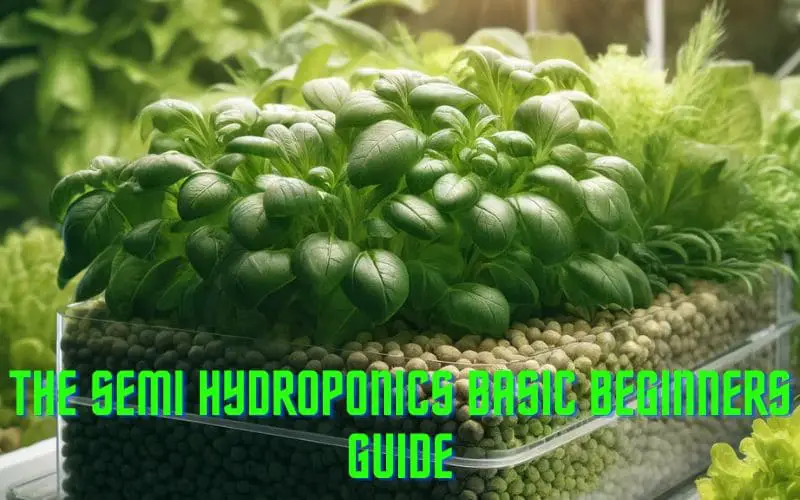The Semi Hydroponics Basic Beginners Guide: Best Growth Tips

Introduction
Welcome to our comprehensive exploration of semi hydroponics. In this article, we will delve into the basics of semi hydroponic gardening, its benefits, plant selection, system setup, maintenance, common issues, and troubleshooting. Whether you’re a beginner or a seasoned gardener, this guide will equip you with the knowledge to embark on your semi hydroponic journey with confidence.
What is Semi Hydroponics?
Semi hydroponics, also known as passive hydroponics or passive sub-irrigation, is a form of hydroponic gardening that uses an inert growing medium instead of soil. The growing medium provides physical support for the plants while wicking up water and nutrients from a reservoir below. This method offers the benefits of hydroponic cultivation while reducing the complexity of traditional hydroponic systems.
- Increased Oxygenation: The inert growing medium in semi hydroponic systems allows for better aeration and oxygenation of the plant roots, promoting healthier and more robust growth.
- Controlled Water and Nutrient Uptake: The wicking action of the medium facilitates controlled uptake of water and nutrients, preventing overwatering or underwatering of the plants.
- Versatility in Growing Conditions: Semi hydroponics can be utilized in various environments, making it suitable for both indoor and outdoor gardening, providing flexibility for plant cultivation.
- Reduced Risk of Soil-Borne Diseases: By eliminating traditional soil, semi hydroponic systems reduce the risk of soil-borne diseases that can affect plant health, resulting in a more hygienic cultivation method.
When implementing a semi hydroponic system, it’s important to select the appropriate inert medium, such as LECA pellets, perlite, or vermiculite, to ensure optimal water retention and aeration for the plants. Additionally, proper monitoring and adjustment of the reservoir’s water and nutrient levels are essential for sustaining healthy plant growth in a semi hydroponic setup.
Benefits of Semi Hydroponics
Semi hydroponics offers a wide range of benefits for plant cultivation. Here are some of the key advantages:
- Efficient Water Usage: Semi hydroponics promotes the efficient use of water, ensuring that plants receive adequate hydration without the risk of water wastage. This is particularly beneficial in regions with water scarcity.
- Precision Nutrient Delivery: One of the distinctive advantages of semi hydroponic systems is the ability to precisely control nutrient delivery to plants. This ensures that the plants receive an optimal balance of essential nutrients for healthy growth.
- Reduction of Soil-Borne Diseases: By minimizing the reliance on soil, semi hydroponic cultivation significantly reduces the risk of soil-borne diseases that can affect plant health. This creates a cleaner and more hygienic growing environment.
- Enhanced Plant Growth: Semi hydroponics encourages faster and more vigorous plant growth compared to traditional soil-based cultivation. The optimized nutrient supply and oxygenated root systems contribute to healthier and more robust plants.
- Space-Efficient Indoor Gardening: For urban gardeners or individuals with limited outdoor space, semi hydroponics offers an attractive solution for cultivating a diverse range of plants indoors. This method allows for efficient space utilization and convenient access to fresh produce.
Choosing Plants for Semi Hydroponics
Choosing plants for semi-hydroponics, also known as hydroculture, involves selecting species that adapt well to water-based environments without soil. Ideal candidates are those with robust root systems that thrive in moist conditions. Common houseplants such as philodendrons, orchids, peace lilies, and anthuriums are excellent choices due to their adaptability and minimal care requirements in semi-hydro setups. When selecting plants, look for healthy specimens without signs of root rot or pest infestations, as these can worsen in a water-based system.
When transitioning plants to a semi-hydroponic system, consider the specific needs of each species, such as light, temperature, and humidity. Start by gently removing all soil from the roots and rinsing them thoroughly to prevent any soil-borne diseases from contaminating the new environment. Use an inert, porous medium like expanded clay pellets or pebbles that allows for good airflow and moisture retention. Monitoring water levels and nutrient concentrations is crucial since the roots are directly exposed to the water solution, requiring careful balance to promote healthy growth and prevent issues like overwatering or nutrient burn.
Setting Up a Semi Hydroponic System
Setting up a semi hydroponic system involves several important steps to ensure the optimal growth of plants. Here’s a detailed guide to setting up a successful semi hydroponic system:
- Choosing the Ideal Growing Medium: Selecting the right growing medium is crucial for semi hydroponic systems. Common choices include perlite, vermiculite, expanded clay pebbles, and coconut coir. Each medium has its unique properties and advantages, so it’s essential to choose one that best suits the specific needs of the plants being grown.
- Understanding Reservoirs and Containers: When setting up a semi hydroponic system, it’s important to choose the appropriate containers and reservoirs. The containers should provide ample space for the plant’s root system and allow for easy monitoring of the nutrient and water levels. Additionally, the reservoir should be designed to efficiently deliver water and nutrients to the plants while ensuring easy access for replenishment.
- Efficient Nutrient and Water Delivery: Ensuring a consistent and efficient delivery of water and nutrients is a key aspect of setting up a semi hydroponic system. This involves setting up a reliable watering schedule, mixing and maintaining nutrient solutions, and implementing a proper drainage system to prevent waterlogging.
- Customizing the System for Specific Plants: Different plants have varying requirements, and it’s important to customize the semi hydroponic system to cater to the specific needs of the chosen plants. This may involve adjusting nutrient levels, pH balance, and environmental factors to create an optimal growing environment.
Maintenance and Care for Semi Hydroponic Plants
- Monitoring Water Levels
- Monitoring Nutrient Concentrations
- Monitoring pH Balance
- Addressing Signs of Nutrient Deficiencies or Plant Stress
A Closer Look
Monitoring water levels in the reservoir is crucial for the well-being of semi hydroponic plants. It’s essential to maintain an appropriate water level to prevent dehydration or overhydration of the roots. Additionally, regular checks for the presence of algae and any accumulation of sediments are essential for ensuring a clean and healthy reservoir environment.
Regular monitoring and adjustment of nutrient concentrations in the reservoir are imperative for providing the plants with the essential elements they need for growth. Understanding the plant’s nutrient requirements and ensuring the availability of these nutrients in the reservoir is vital for sustaining healthy plant development.
Pruning roots is a critical aspect of maintaining semi hydroponic plants. The removal of unhealthy or overcrowded roots promotes better nutrient absorption and prevents the risk of root rot. It’s essential to perform root pruning carefully to avoid damage to the plant and to encourage new healthy root growth.
Ensuring the appropriate pH balance of the nutrient solution is necessary for the optimal uptake of nutrients by the plants. Regular monitoring and adjustment of pH levels help prevent nutrient lockout and maintain the overall health and vigor of the plants.
Identifying and addressing signs of nutrient deficiencies or plant stress is essential for preventing detrimental effects on plant growth. Understanding the visual cues of nutrient deficiencies and stress responses in plants allows for prompt intervention and adjustments to the care routine to support healthy plant development.
Each plant species has specific preferences and requirements for optimal growth in a semi hydroponic environment. Understanding the unique needs of the chosen plant species, such as light levels, humidity, and airflow, is crucial for providing the best possible care and ensuring thriving growth.
Common Issues and Troubleshooting
Semi hydroponics, while being a highly efficient gardening method, is susceptible to a range of common issues. It’s important for gardeners to be well-informed about these potential problems so that they can be addressed effectively. Let’s delve deeper into the common issues and troubleshooting techniques associated with semi hydroponic gardening:
- Root Rot: One of the most prevalent issues in semi hydroponics is the occurrence of root rot. This can be caused by overwatering, poor drainage, or unsuitable growing medium. Proper aeration and maintaining optimum moisture levels are essential to prevent root rot.
- Nutrient Imbalances: Maintaining a balance of nutrients in the nutrient solution is crucial for the health and growth of plants. Nutrient imbalances can lead to stunted growth, discoloration of leaves, and overall poor plant health. Regular monitoring and adjusting the nutrient solution composition is necessary to avoid nutrient imbalances.
- Inadequate Aeration: Insufficient oxygenation of the root system can result in reduced nutrient uptake and overall plant vigor. Ensuring proper aeration of the growing medium, especially in closed systems, is vital for the well-being of the plants.
Recognizing and addressing these common issues is pivotal for the success of semi hydroponic gardening. By implementing effective troubleshooting techniques, gardeners can maintain healthy, thriving plants and optimize the productivity of their semi hydroponic systems.
Conclusion
Congratulations on completing this comprehensive guide to semi hydroponics. We’ve covered all essentials for starting your semi-hydroponic journey confidently, including selection, setup, maintenance, and troubleshooting. As you apply the knowledge gained from this guide, may your semi hydroponic endeavors yield abundant harvests and flourishing greenery.
